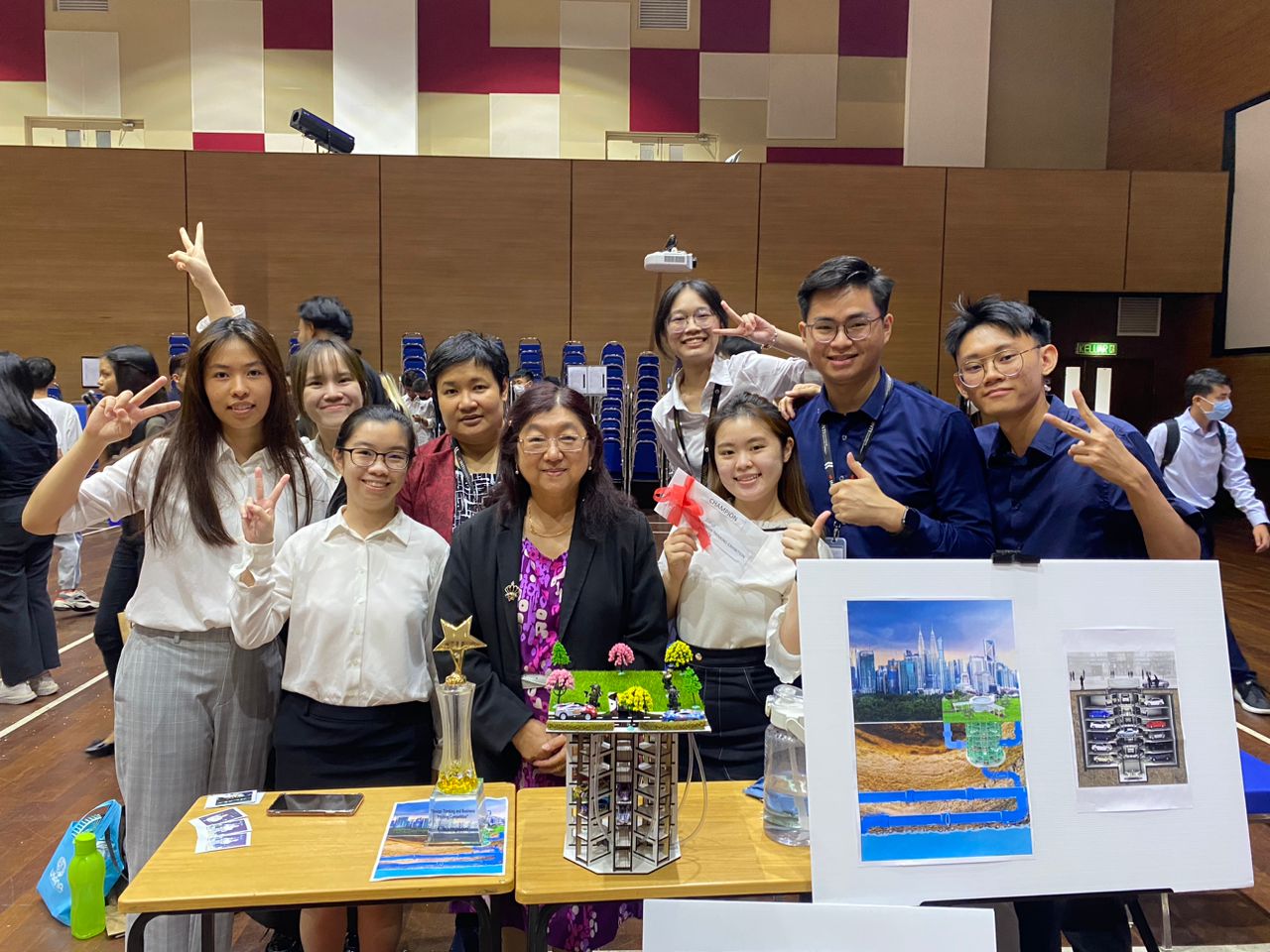The effects of climate change continues to impact Malaysia, with urban areas facing greater risk of floods brought on by heavy rain. In 2021 alone, Malaysia saw its worst floods in decades which drew criticism regarding the government’s handling of the crisis[1].
Through their Design Thinking module, a compulsory subject for degree students at INTI, the group of Bachelor of Business students from INTI International University may have found a solution to mitigate floods sustainably. Their project won first prize, beating 56 other groups in the Design Thinking Competition held in conjunction with the Social Innovation Exhibition organised by the Faculty of Education and Liberal Arts (FELA) in April.
The group made up of Lim Chee Chiang, Yong Kah Chun, Wang Chern Xin, Ho Kai Sze, Tang Yee Leng, Yau Wan Xin, and Ang Jun Min, built a prototype known as “The Subterranean E-Parking with Advanced Drainage System” to alleviate flooding and reduce traffic in the city.
Addressing some of society’s most pressing challenges, their project aimed address three United Nations Sustainable Development Goals (SDGs), namely Zero Hunger and Sustainable Agriculture (Goal 2) to ensure that people everywhere have quality food to lead a healthy life; Good Health, and Well-Being (Goal 3) which aims to ensure healthy lives and promote well-being for all at all ages; Clean Water and Sanitation (Goal 6) for the availability and sustainable management of water and sanitation for all; and Sustainable Cities and Communities (Goal 11) to make cities and human settlements inclusive, safe, resilient, and sustainable.
“Our prototype is an underground car park that integrates stormwater and drainage management systems powered by artificial intelligence (AI). When heavy rain occurs, the system will capture the water, store it, and let it gradually flow towards the nearest river, lake, and ocean,” said Lim Chee Chiang, adding that a good drainage system helps prevent flooding, reduce the risk of waterborne diseases, and protect critical infrastructure and public spaces from water damage.
Project leader Chee Chiang said the prototype not only has the potential to save lives, but can also help reduce traffic congestion in cities.
“Our automated underground car park will send a signal and allow drivers to easily find a spot in designated spaces. Cars can move in any direction and be parked automatically, saving both energy and time.

The winners of the Design Thinking Competition proudly posing with the prototype of their project titled “The Subterranean E-Parking with Advanced Drainage System”, together with their lecturer, Prof. Ir. Dr. Leong Wai Yie (fourth from left) and Dr. Amy Lim (centre), Chief Executive Officer, Ler Lum Advisory Services Sdn. Bhd. who is also their mentor for this project.
“For example, if the water level has reached the 5th floor, the cars will be moved automatically. Combine with the intelligence calculation system, we can prevent floods from happening and move the cars of customers above the top level of the underground car park,” he said.
The team worked relentlessly from January to April 2023 to achieve their goals and successfully complete the project.
“Our team aims to address the unresolved issue of flash floods in Malaysia while fulfilling the demand for car parking in urban areas, especially those that are prone to heavy flooding.
“We hope to build up to ten or more underground car parks incorporated with a storm management system, which will make our design to become the second largest storm management system after the Stormwater Management and Road Tunnel (SMART),” he said.
When asked about what made their design unique from the existing SMART tunnel in Malaysia, he said their location strategy sets them apart.
“Studies indicate that the SMART tunnel can only assist with flash floods in Bukit Bintang and neighbouring areas, but it does not solve the issue of flash floods in other areas in the Klang Valley or across the nation. Our design can be built anywhere and resolve the flash flood problem in the area,” he said.
Lim also shared that budget estimation was another challenge faced by the team as it affected the whole design.
“Excavating 15 metres deep may encounter hard rocks or stones so this will need professionals to create a material that can withstand the stress of the underground car park. It is also difficult to develop a tunnel between the underground car park and the nearest river, lake, and ocean requires, so having experts to develop it will make the project successful,” he said, adding that these limitations encouraged the team to be more creative in searching for alternative sources.
Reflecting on their 14-week journey to complete the prototype, he said their initial plan was to design a hydra barrier or sandbag which allows houses to block floods from entering their homes.
“If no preventive action is taken, the flash flood issue may persist. I figured the underground car park would be the best solution as a temporary reservoir for the stormwater so that we can preserve the properties above ground. When I first proposed the idea, the team figured that it is similar to the SMART tunnel in Malaysia, except that it integrates the concept of an underground parking with a cutting-edge storm drainage system,” he added.
Ending the interview, Lim expressed his gratitude that INTI included the Design Thinking module in the syllabus as it taught students critical thinking, resilience, teamwork, and problem-solving – skills that are valuable for graduates as they begin their careers.
[1] https://edition.cnn.com/2023/03/05/asia/johor-malaysia-floods-intl-hnk/index.html